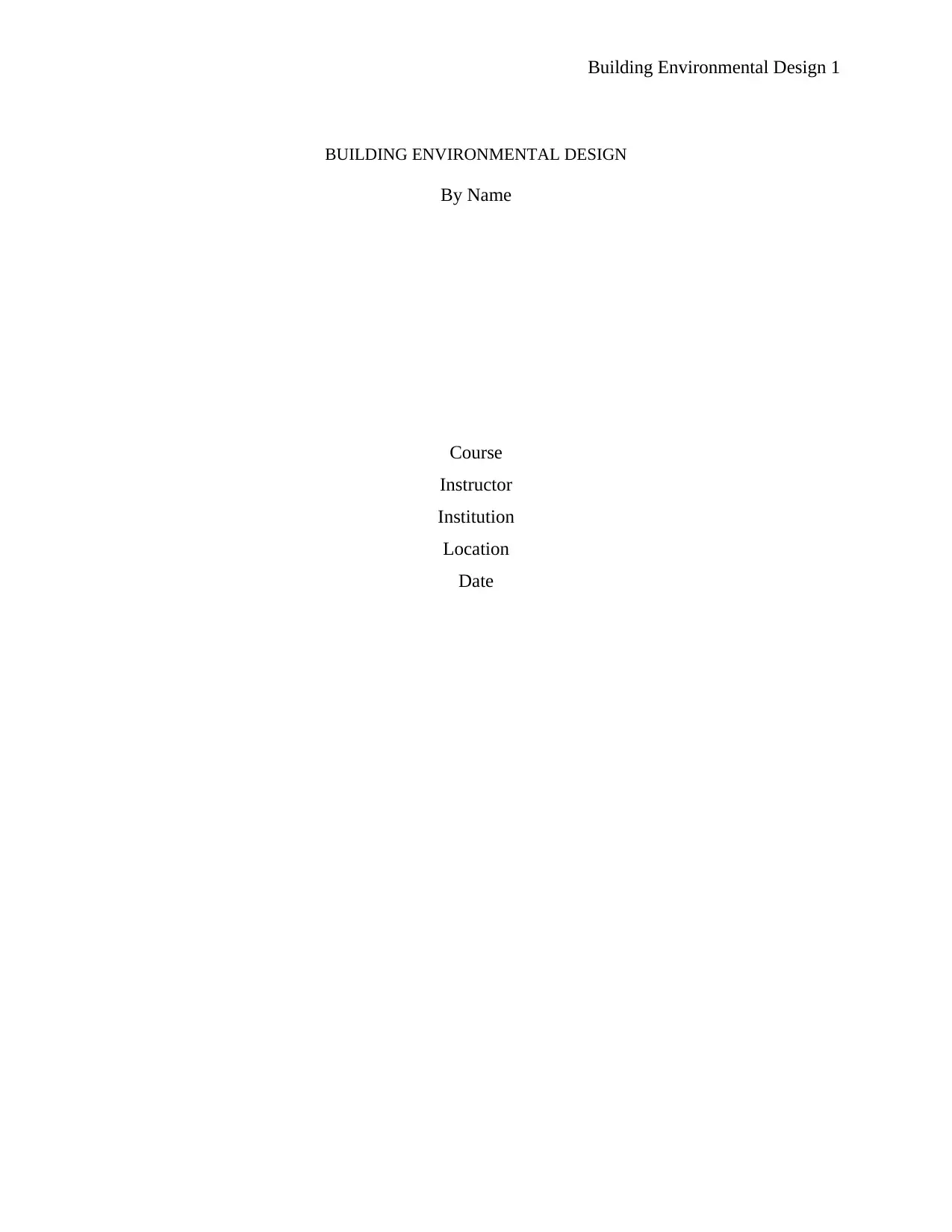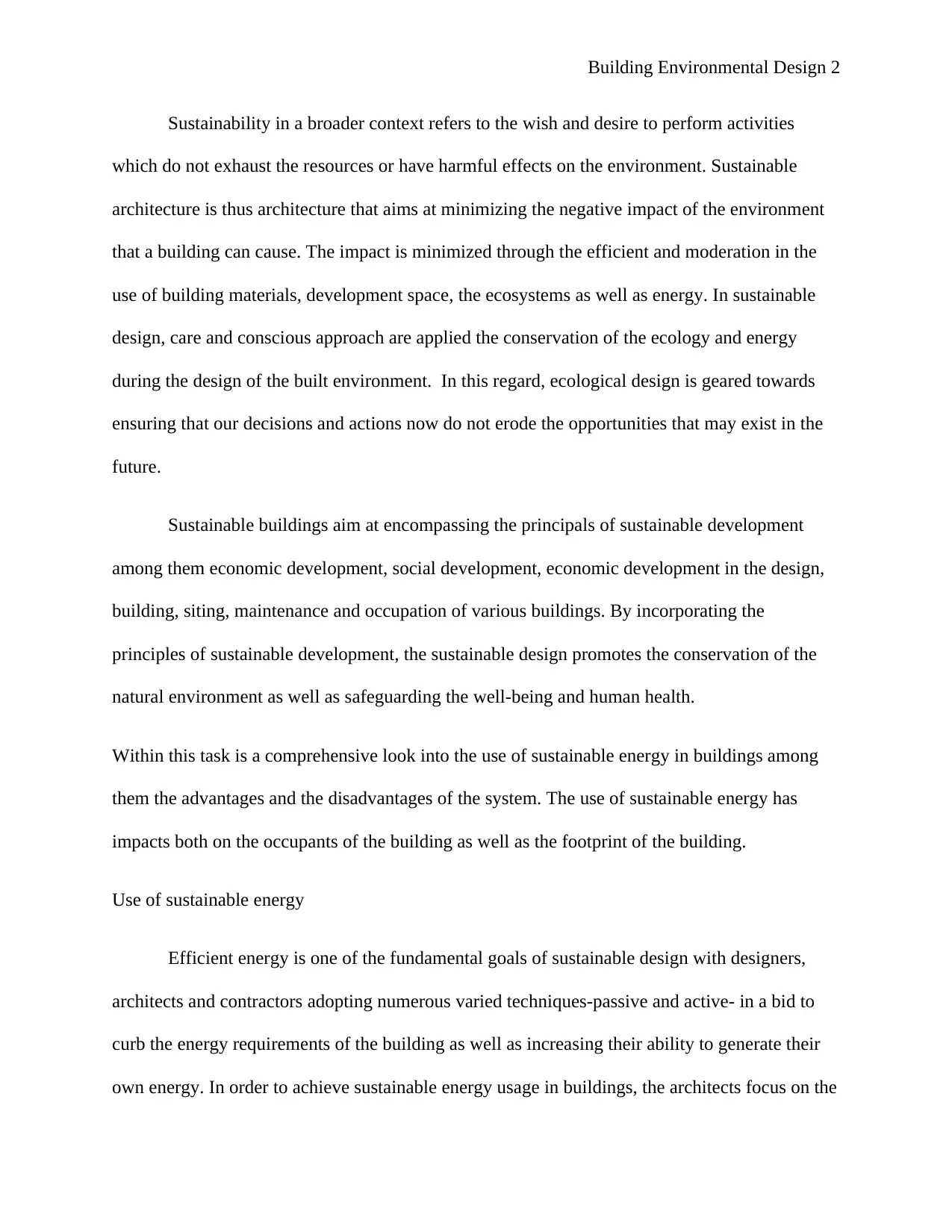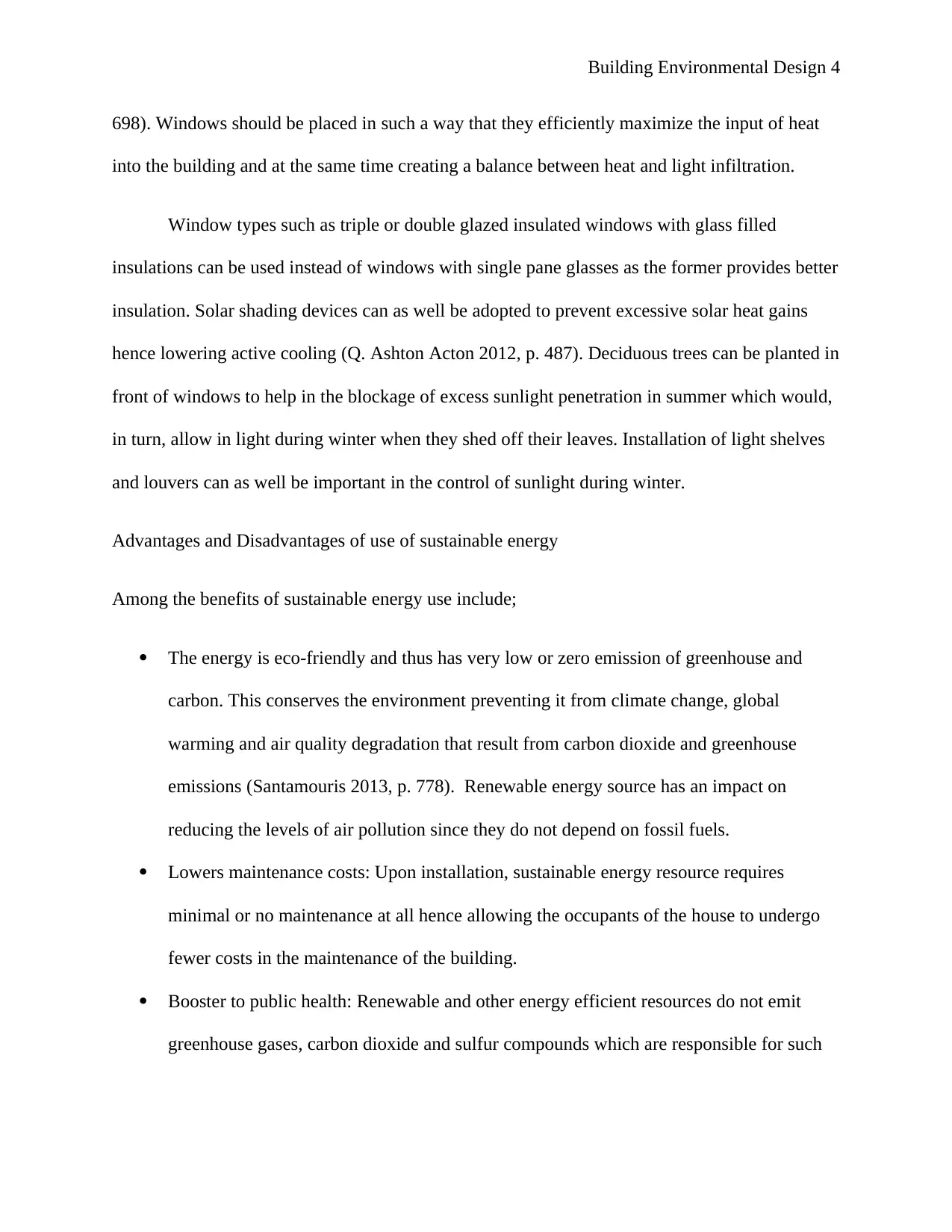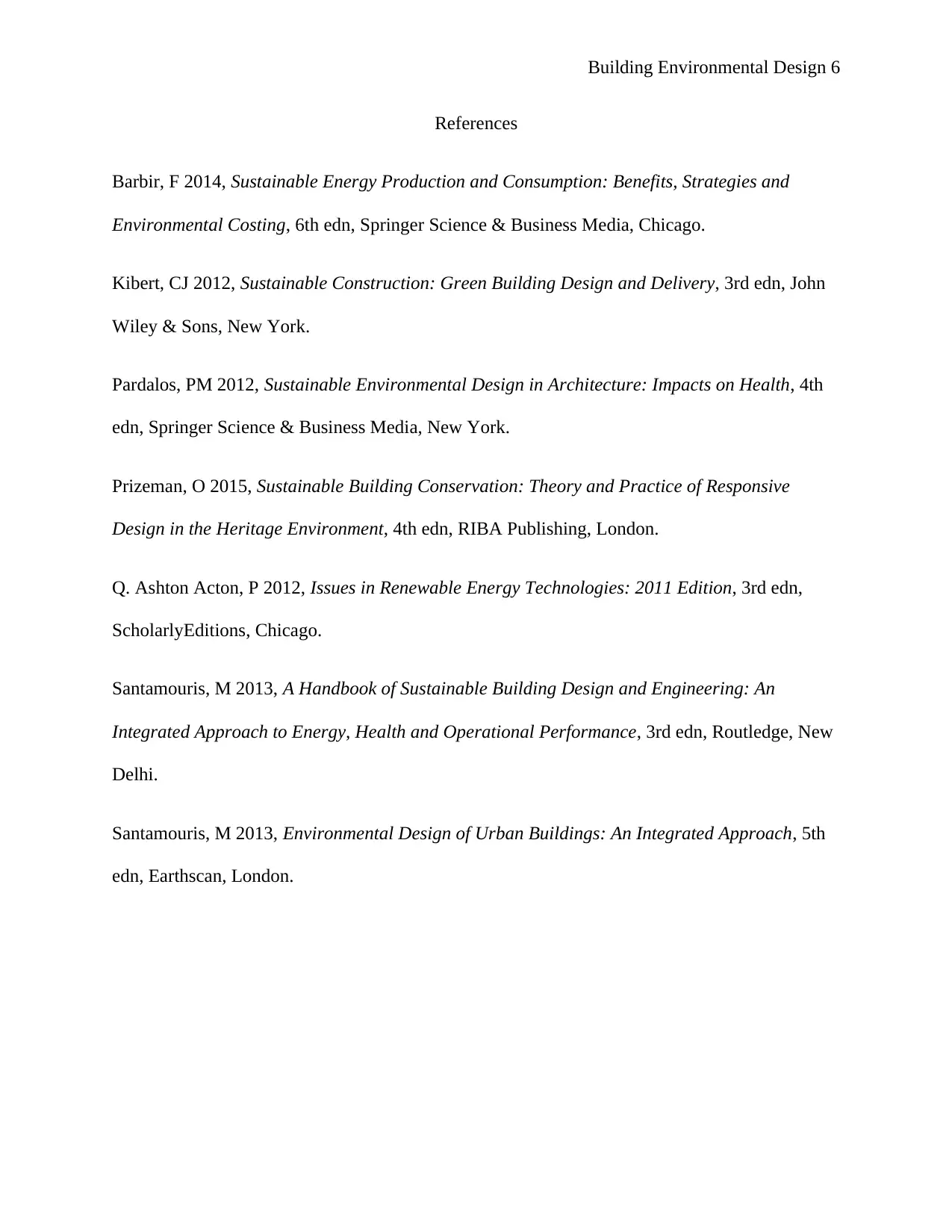Sustainable Energy Use in Building Environmental Design
VerifiedAdded on 2020/02/24
|6
|1332
|55
Report
AI Summary
This report provides a comprehensive overview of sustainable energy in building environmental design. It begins by defining sustainable architecture and its goals, emphasizing the minimization of environmental impact through efficient resource use and ecological design. The report explores the integration of sustainable energy sources, including solar and wind power, and discusses strategies for improving the efficiency of heating, cooling, and ventilation systems. It details the advantages of sustainable energy, such as reduced emissions, lower maintenance costs, and improved public health, while also addressing the disadvantages, including the non-reliability of renewable resources, potential insufficient energy generation, and high initial installation costs. The report references key literature to support its findings, offering valuable insights into the practical applications and implications of sustainable energy in the built environment.

Building Environmental Design 1
BUILDING ENVIRONMENTAL DESIGN
By Name
Course
Instructor
Institution
Location
Date
BUILDING ENVIRONMENTAL DESIGN
By Name
Course
Instructor
Institution
Location
Date
Paraphrase This Document
Need a fresh take? Get an instant paraphrase of this document with our AI Paraphraser

Building Environmental Design 2
Sustainability in a broader context refers to the wish and desire to perform activities
which do not exhaust the resources or have harmful effects on the environment. Sustainable
architecture is thus architecture that aims at minimizing the negative impact of the environment
that a building can cause. The impact is minimized through the efficient and moderation in the
use of building materials, development space, the ecosystems as well as energy. In sustainable
design, care and conscious approach are applied the conservation of the ecology and energy
during the design of the built environment. In this regard, ecological design is geared towards
ensuring that our decisions and actions now do not erode the opportunities that may exist in the
future.
Sustainable buildings aim at encompassing the principals of sustainable development
among them economic development, social development, economic development in the design,
building, siting, maintenance and occupation of various buildings. By incorporating the
principles of sustainable development, the sustainable design promotes the conservation of the
natural environment as well as safeguarding the well-being and human health.
Within this task is a comprehensive look into the use of sustainable energy in buildings among
them the advantages and the disadvantages of the system. The use of sustainable energy has
impacts both on the occupants of the building as well as the footprint of the building.
Use of sustainable energy
Efficient energy is one of the fundamental goals of sustainable design with designers,
architects and contractors adopting numerous varied techniques-passive and active- in a bid to
curb the energy requirements of the building as well as increasing their ability to generate their
own energy. In order to achieve sustainable energy usage in buildings, the architects focus on the
Sustainability in a broader context refers to the wish and desire to perform activities
which do not exhaust the resources or have harmful effects on the environment. Sustainable
architecture is thus architecture that aims at minimizing the negative impact of the environment
that a building can cause. The impact is minimized through the efficient and moderation in the
use of building materials, development space, the ecosystems as well as energy. In sustainable
design, care and conscious approach are applied the conservation of the ecology and energy
during the design of the built environment. In this regard, ecological design is geared towards
ensuring that our decisions and actions now do not erode the opportunities that may exist in the
future.
Sustainable buildings aim at encompassing the principals of sustainable development
among them economic development, social development, economic development in the design,
building, siting, maintenance and occupation of various buildings. By incorporating the
principles of sustainable development, the sustainable design promotes the conservation of the
natural environment as well as safeguarding the well-being and human health.
Within this task is a comprehensive look into the use of sustainable energy in buildings among
them the advantages and the disadvantages of the system. The use of sustainable energy has
impacts both on the occupants of the building as well as the footprint of the building.
Use of sustainable energy
Efficient energy is one of the fundamental goals of sustainable design with designers,
architects and contractors adopting numerous varied techniques-passive and active- in a bid to
curb the energy requirements of the building as well as increasing their ability to generate their
own energy. In order to achieve sustainable energy usage in buildings, the architects focus on the

Building Environmental Design 3
environmental resources that are available locally and also influence other factors that are related
to energy, for example, ventilation, daylight and solar heat gains. The use of site analysis is vital
in ensuring maximum exploitation of these natural and energy-related factors. These factors
include;
Generation of renewable energy
The renewable energy sources that can be generated on site include solar energy which is
tapped from sunlight by the use of photovoltaic cells, wind energy tapped by wind turbines,
domestic water systems as well as heat pumps. The site experiences winds from the Northeast
Sector. This wind can be tapped using wind turbines to produce energy (Pardalos 2012, p. 556).
The turbines should be placed in such a way that they tap maximum wind on windy days and to
the North East sector since this side of the site receives quite a constant amount of wind. In order
to increase the maximization of the energy production through wind, small wind turbines can be
located on top of the roofs of the individual buildings. The energy tapped would accommodate
up to 25% of the domestic energy requirement of the buildings.
Having active photovoltaic solar panels on the roofs of the building can also be adopted
as a mean of providing sustainable electricity for the buildings. In order to maximize the energy
production through solar panels on this site, the photovoltaic cells should be should be oriented
towards the south (Santamouris 2013, p. 699).
Efficiency of heating, cooling and ventilation systems
Among the passive architectural strategies in achieving this efficiency include window
orientation and size and arrangement of the rooms or spaces in a building (Prizeman 2015, p.
environmental resources that are available locally and also influence other factors that are related
to energy, for example, ventilation, daylight and solar heat gains. The use of site analysis is vital
in ensuring maximum exploitation of these natural and energy-related factors. These factors
include;
Generation of renewable energy
The renewable energy sources that can be generated on site include solar energy which is
tapped from sunlight by the use of photovoltaic cells, wind energy tapped by wind turbines,
domestic water systems as well as heat pumps. The site experiences winds from the Northeast
Sector. This wind can be tapped using wind turbines to produce energy (Pardalos 2012, p. 556).
The turbines should be placed in such a way that they tap maximum wind on windy days and to
the North East sector since this side of the site receives quite a constant amount of wind. In order
to increase the maximization of the energy production through wind, small wind turbines can be
located on top of the roofs of the individual buildings. The energy tapped would accommodate
up to 25% of the domestic energy requirement of the buildings.
Having active photovoltaic solar panels on the roofs of the building can also be adopted
as a mean of providing sustainable electricity for the buildings. In order to maximize the energy
production through solar panels on this site, the photovoltaic cells should be should be oriented
towards the south (Santamouris 2013, p. 699).
Efficiency of heating, cooling and ventilation systems
Among the passive architectural strategies in achieving this efficiency include window
orientation and size and arrangement of the rooms or spaces in a building (Prizeman 2015, p.
⊘ This is a preview!⊘
Do you want full access?
Subscribe today to unlock all pages.

Trusted by 1+ million students worldwide

Building Environmental Design 4
698). Windows should be placed in such a way that they efficiently maximize the input of heat
into the building and at the same time creating a balance between heat and light infiltration.
Window types such as triple or double glazed insulated windows with glass filled
insulations can be used instead of windows with single pane glasses as the former provides better
insulation. Solar shading devices can as well be adopted to prevent excessive solar heat gains
hence lowering active cooling (Q. Ashton Acton 2012, p. 487). Deciduous trees can be planted in
front of windows to help in the blockage of excess sunlight penetration in summer which would,
in turn, allow in light during winter when they shed off their leaves. Installation of light shelves
and louvers can as well be important in the control of sunlight during winter.
Advantages and Disadvantages of use of sustainable energy
Among the benefits of sustainable energy use include;
The energy is eco-friendly and thus has very low or zero emission of greenhouse and
carbon. This conserves the environment preventing it from climate change, global
warming and air quality degradation that result from carbon dioxide and greenhouse
emissions (Santamouris 2013, p. 778). Renewable energy source has an impact on
reducing the levels of air pollution since they do not depend on fossil fuels.
Lowers maintenance costs: Upon installation, sustainable energy resource requires
minimal or no maintenance at all hence allowing the occupants of the house to undergo
fewer costs in the maintenance of the building.
Booster to public health: Renewable and other energy efficient resources do not emit
greenhouse gases, carbon dioxide and sulfur compounds which are responsible for such
698). Windows should be placed in such a way that they efficiently maximize the input of heat
into the building and at the same time creating a balance between heat and light infiltration.
Window types such as triple or double glazed insulated windows with glass filled
insulations can be used instead of windows with single pane glasses as the former provides better
insulation. Solar shading devices can as well be adopted to prevent excessive solar heat gains
hence lowering active cooling (Q. Ashton Acton 2012, p. 487). Deciduous trees can be planted in
front of windows to help in the blockage of excess sunlight penetration in summer which would,
in turn, allow in light during winter when they shed off their leaves. Installation of light shelves
and louvers can as well be important in the control of sunlight during winter.
Advantages and Disadvantages of use of sustainable energy
Among the benefits of sustainable energy use include;
The energy is eco-friendly and thus has very low or zero emission of greenhouse and
carbon. This conserves the environment preventing it from climate change, global
warming and air quality degradation that result from carbon dioxide and greenhouse
emissions (Santamouris 2013, p. 778). Renewable energy source has an impact on
reducing the levels of air pollution since they do not depend on fossil fuels.
Lowers maintenance costs: Upon installation, sustainable energy resource requires
minimal or no maintenance at all hence allowing the occupants of the house to undergo
fewer costs in the maintenance of the building.
Booster to public health: Renewable and other energy efficient resources do not emit
greenhouse gases, carbon dioxide and sulfur compounds which are responsible for such
Paraphrase This Document
Need a fresh take? Get an instant paraphrase of this document with our AI Paraphraser

Building Environmental Design 5
lifestyle diseases as cancer and heart-related infections (Santamouris 2013, p. 598). These
resources, therefore, improve the well-being and health of the occupants of the house.
Among the disadvantages include;
Non-reliability of these energy resources since most of them depend on natural
factors which cannot be controlled by human (Kibert 2012, p. 336)
The amount of electricity generated by these resources in most cases is not sufficient
and enough to meet the needs of the home. The energy yielded from these resources
in most cases meets barely half of the domestic energy requirement of the different
households.
Sustainable energy resources require high capital to install.
Incorporation of these energy efficient strategies would culminate into additional costs both to
the consumer and the construction industry at large (Pardalos 2012, p. 168). The setting up of
such facilities as wind turbines, active photovoltaic cells and even hydroelectricity power plants
require heavy investments that are relatively expensive and may lead to additional costs. Besides
the initial installation costs, other costs such as maintenance expenses would need to be
incorporated in order to reap from such developments. The resources would also require careful
and consideration in the planning and implementation stages.
lifestyle diseases as cancer and heart-related infections (Santamouris 2013, p. 598). These
resources, therefore, improve the well-being and health of the occupants of the house.
Among the disadvantages include;
Non-reliability of these energy resources since most of them depend on natural
factors which cannot be controlled by human (Kibert 2012, p. 336)
The amount of electricity generated by these resources in most cases is not sufficient
and enough to meet the needs of the home. The energy yielded from these resources
in most cases meets barely half of the domestic energy requirement of the different
households.
Sustainable energy resources require high capital to install.
Incorporation of these energy efficient strategies would culminate into additional costs both to
the consumer and the construction industry at large (Pardalos 2012, p. 168). The setting up of
such facilities as wind turbines, active photovoltaic cells and even hydroelectricity power plants
require heavy investments that are relatively expensive and may lead to additional costs. Besides
the initial installation costs, other costs such as maintenance expenses would need to be
incorporated in order to reap from such developments. The resources would also require careful
and consideration in the planning and implementation stages.

Building Environmental Design 6
References
Barbir, F 2014, Sustainable Energy Production and Consumption: Benefits, Strategies and
Environmental Costing, 6th edn, Springer Science & Business Media, Chicago.
Kibert, CJ 2012, Sustainable Construction: Green Building Design and Delivery, 3rd edn, John
Wiley & Sons, New York.
Pardalos, PM 2012, Sustainable Environmental Design in Architecture: Impacts on Health, 4th
edn, Springer Science & Business Media, New York.
Prizeman, O 2015, Sustainable Building Conservation: Theory and Practice of Responsive
Design in the Heritage Environment, 4th edn, RIBA Publishing, London.
Q. Ashton Acton, P 2012, Issues in Renewable Energy Technologies: 2011 Edition, 3rd edn,
ScholarlyEditions, Chicago.
Santamouris, M 2013, A Handbook of Sustainable Building Design and Engineering: An
Integrated Approach to Energy, Health and Operational Performance, 3rd edn, Routledge, New
Delhi.
Santamouris, M 2013, Environmental Design of Urban Buildings: An Integrated Approach, 5th
edn, Earthscan, London.
References
Barbir, F 2014, Sustainable Energy Production and Consumption: Benefits, Strategies and
Environmental Costing, 6th edn, Springer Science & Business Media, Chicago.
Kibert, CJ 2012, Sustainable Construction: Green Building Design and Delivery, 3rd edn, John
Wiley & Sons, New York.
Pardalos, PM 2012, Sustainable Environmental Design in Architecture: Impacts on Health, 4th
edn, Springer Science & Business Media, New York.
Prizeman, O 2015, Sustainable Building Conservation: Theory and Practice of Responsive
Design in the Heritage Environment, 4th edn, RIBA Publishing, London.
Q. Ashton Acton, P 2012, Issues in Renewable Energy Technologies: 2011 Edition, 3rd edn,
ScholarlyEditions, Chicago.
Santamouris, M 2013, A Handbook of Sustainable Building Design and Engineering: An
Integrated Approach to Energy, Health and Operational Performance, 3rd edn, Routledge, New
Delhi.
Santamouris, M 2013, Environmental Design of Urban Buildings: An Integrated Approach, 5th
edn, Earthscan, London.
⊘ This is a preview!⊘
Do you want full access?
Subscribe today to unlock all pages.

Trusted by 1+ million students worldwide
1 out of 6
Related Documents
Your All-in-One AI-Powered Toolkit for Academic Success.
+13062052269
info@desklib.com
Available 24*7 on WhatsApp / Email
![[object Object]](/_next/static/media/star-bottom.7253800d.svg)
Unlock your academic potential
Copyright © 2020–2025 A2Z Services. All Rights Reserved. Developed and managed by ZUCOL.





